KDE
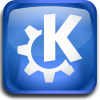 |
|
| Founders | Matthias Ettrich |
|---|---|
| Type | Community |
| Founded | 14 October 1996 |
| Key people | Cornelius Schumacher |
| Products | KDE Software Compilation, KOffice, KDevelop, Amarok, K3b, etc. |
| Focus | Free software |
| Method | Artwork, Development, Documentation, Promotion, and Translation. |
| Motto | Experience Freedom! |
| Website | KDE.org |
KDE (pronounced /ˌkeɪdiːˈiː/) is an international free software community producing an integrated set of cross-platform applications designed to run on Linux, FreeBSD, Windows, Solaris and Mac OS X systems.[1][2] It is best known for its Plasma Desktop workspace, a desktop environment provided as the default working environment on many Linux distributions, such as openSUSE, Mandriva Linux, Kubuntu, Red Flag Linux, and Pardus.
The goal of the project is to provide basic desktop functions and applications for daily needs as well as tools and documentation for developers to write stand-alone applications for the system. In this regard, the KDE project serves as an umbrella project for many standalone applications and smaller projects that are based on KDE technology. These include KOffice, KDevelop, Amarok, K3b and many others. KDE software is based on the Qt application framework , although it has also support for programs based on GTK, as well as the GTK-based visual themes.[3] The original GPL version of this toolkit only existed for the X11 platform, but with the release of Qt 4, LGPL versions are available for all platforms. This allows KDE software based on Qt 4 to also be distributed to Microsoft Windows and Mac OS X.
Contents |
History
Origins
KDE was founded in 1996 by Matthias Ettrich, who was then a student at the Eberhard Karls University of Tübingen. At the time, he was troubled by certain aspects of the Unix desktop. Among his qualms was that none of the applications looked, felt, or worked alike. He proposed the formation of not only a set of applications, but rather a desktop environment, in which users could expect things to look, feel, and work consistently. He also wanted to make this desktop easy to use; one of his complaints with desktop applications of the time was that his girlfriend could not use them. His initial Usenet post spurred a lot of interest, and the KDE project was born.[4]
The name KDE was intended as a word play on the existing Common Desktop Environment, available for Unix systems. CDE was an X11-based user environment jointly developed by HP, IBM, and Sun, through the X/Open Company, with an interface and productivity tools based on the Motif graphical widget toolkit. It was supposed to be an intuitively easy-to-use desktop computer environment.[5] The K was originally suggested to stand for "Kool", but it was quickly decided that the K should stand for nothing in particular - thus the KDE acronym expanded to "K Desktop Environment". Additionally, one of the tips in certain versions of KDE 3 incorrectly states that the K currently is just meant to be the letter before L in the Latin alphabet, the first letter in the word Linux (which is where KDE is usually run).[6] In 2009, with ports to Windows and Mac OS X and popular applications such as Amarok released, KDE was no longer just a desktop and it was decided that the name should no longer be an acronym at all.
Matthias Ettrich chose to use Trolltech's Qt application framework for the KDE project. Other programmers quickly started developing KDE/Qt applications, and by early 1997, a few applications were being released.
First series

On 12 July 1998 KDE 1.0 was released. In November 1998, the Qt toolkit was dual-licensed under the free/open source Q Public License (QPL) & a proprietary-license for proprietary software developers. The same year, the KDE Free Qt foundation[7] was created which guarantees that Qt would fall under a variant of the very liberal BSD license should Trolltech cease to exist or no free/open source version of Qt be released during 12 months. Debate continued about compatibility with the GNU General Public License (GPL), so in September 2000, Trolltech made the Unix version of the Qt libraries available under the GPL, in addition to the QPL, which eliminated the concerns of the Free Software Foundation. Trolltech continued to require licenses for developing proprietary software with Qt. The core libraries of KDE are collectively licensed under the GNU LGPL, but the only way for proprietary software to make use of them was to be developed under the terms of the Qt proprietary license.
Second series

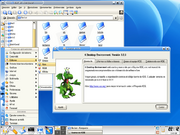
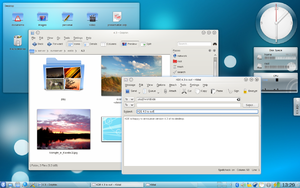
The second series of releases, KDE 2, introduced significant technological improvements.[9] These included DCOP (Desktop COmmunication Protocol), KIO, an application I/O library, KParts, a component object model, allowing an application to embed another within itself, and KHTML, an HTML rendering and drawing engine.[9]
Third release
The third series was much larger than the previous series, consisting of six major releases. The API changes between KDE 2 and KDE 3 were comparatively minor, meaning that the KDE 3 can be seen as largely a continuation of the KDE 2 series. All releases of KDE 3 were built upon Qt 3, which was only released under the GPL for Linux and Unix-like operating systems, including Mac OS X. For that reason, KDE 3 was only available on Windows through ports involving an X server. KDE 3.x is marked stable running on Mac OS X since 2008. Unlike KDE 4, however, it requires an X11 server to operate.[10]
Fourth series
KDE Software Compilation 4 is based on Qt 4, which is also released under the GPL for Windows and Mac OS X. Therefore KDE SC 4 applications can be compiled and run natively on these operating systems as well. KDE Software compilation 4 on Mac OS X is currently considered beta ,[11] while on Windows it is not in the final state, so applications can be unsuitable for day to day use yet.[12]
KDE SC 4 includes many new technologies and technical changes. The centerpiece is a redesigned desktop and panels collectively called Plasma which replaces Kicker, KDesktop, and SuperKaramba by integrating their functionality into one piece of technology, and is intended to be more configurable for those wanting to update the decades-old desktop metaphor. There are a number of new frameworks, including Phonon, a new multimedia interface making KDE independent of any one specific media backend, Solid, an API for network and portable devices, and Decibel, a new communication framework to integrate all communication protocols into the desktop. Also featured is a metadata and search framework, incorporating Strigi as a full-text file indexing service, and NEPOMUK with KDE integration.[13]
Qt 4.5 LGPL licensing option
Starting with Qt 4.5, Qt was also made available under the LGPL version 2.1,[14] a major step for KDE adoption in corporate and proprietary environments. This allows KDE to better compete with GNOME, Xfce and EDE which use toolkits licensed under the LGPL, because the LGPL permits proprietary applications to link to libraries licensed under the LGPL.
Organization
Like many free/open source software projects, KDE is primarily a volunteer effort, although various companies, such as Novell (in the form of SuSE), Nokia, and Mandriva, employ developers to work on the project. Since a large number of individuals contribute to KDE in various ways (e.g. code, translation, artwork), organization of such a project is complex. Most problems are discussed on a number of different mailing lists. Important decisions, such as release dates and inclusion of new applications, are made on the kde-core-devel list by core developers. These are developers who have made significant contributions to KDE over a long period of time. Decisions are made by outcomes of democratic voting procedures.[15] In most cases this seems to work well, and major debates (such as the question of whether the KDE 2 API should be broken in favour of KDE 3) are rare.
The KDE project and related events are frequently sponsored by individuals, universities, and businesses.[16] On 15 October 2006, it was announced that Mark Shuttleworth had become the first patron of KDE, the highest level of sponsorship available.[17] On 7 July 2007, it was announced that Intel Corporation and Novell had also become patrons of KDE.[18]
While developers and users are now located all over the world, the project retains a strong base in Germany. The web servers are located at the universities of Tübingen and Kaiserslautern, a German non-profit organization (KDE e.V.) owns the trademark on KDE and KDE conferences often take place in Germany arranged by its artists.
Identity
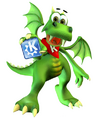
Many KDE applications have a K in the name, mostly as an initial letter. The K in many KDE applications is obtained by spelling a word which originally begins with C or Q differently, for example Konsole and Kommander. Also, some just prefix a commonly used word with a K, for instance KOffice. Among KDE 4 applications and technologies, however, the trend is not to have a K in the name at all, such as Plasma and Dolphin.
The KDE project's mascot is a green dragon named Konqi.
Brand repositioning
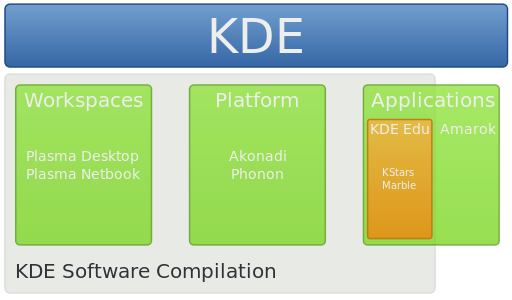
On 24 November 2009 the KDE Marketing Team announced [19] an official rebranding of the KDE project components, motivated by the perceived shift from building a desktop environment to a complete project around a community of "people who create software". The rebranding focused on de-emphasizing the desktop environment as "just another product", and emphasizing both the community and the other technologies provided as KDE software.
After the repositioning, the name KDE loses the old K Desktop Environment acronym and now acts as an umbrella brand for the hierarchy of different brands for software components:
- KDE Platform for the libraries and services.
- KDE Applications for products built on top of the KDE Platform. The new brand is intended to emphasize that KDE apps can potentially be portable between operating systems and independent of a particular workspace or desktop environment.
- KDE Workspaces for different available GUI environments, either following the desktop metaphor or adapted to other metaphors and devices such as netbooks and smartphones.
- KDE Software Compilation for the coordinated releases of new software versions, gathering elements from the previous components to build an integrated core of software. What would have been previously known as KDE 4.4 will now be referred as "KDE Software Compilation 4.4" (abbreviated "KDE SC 4.4").
Conferences
The two most important Conferences of KDE are Akademy and Camp KDE. They are both thematically and geographically widely-scale events.
Akademy
Akademy is held at varying venues in Europe since 2003.
Camp KDE
Camp KDE, an annual contributor's conference of the KDE community held in the Americas since 2009.
Other conferences
In addition to Camp KDE and Akademy there are other conferences:
- Akademy-BR – It was addressed to Brazilian KDE contributors.[23]
- Tokamak – The meeting of designers and developers of Plasma, KWin, and Oxygen.
Development
KDE software is built using the Qt application framework which runs on most Unix and Unix-like systems, Mac OS X and Microsoft Windows.
Cornelius Schumacher, a main developer within KDE,[24] wrote about the estimated cost (using the COCOMO model with SLOCCount) to develop KDE software package with 4,273,291 LoC, which would be about US$175,364,716.[25] This estimation doesn't include Qt, KOffice, Amarok, Digikam, and other applications that are not part of KDE core.
Collaborations with other organizations
freedesktop.org
freedesktop.org is a collaboration platform with the goal of standardize Unix desktop interoperability.
Wikimedia
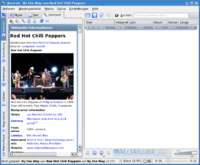
On 23 June 2005, it was announced that the KDE project and the Wikimedia Foundation seek a cooperation.[26] In particular, the content of Wikimedia projects over a Web service interface for KDE programs offer.
Commercial operating companies
The software development and consulting companies Intevation GmbH of Germany and the Swedish Klarälvdalens Datakonsult AB (KDAB) use Qt and KDE software – especially Kontact and Akonadi for Kolab – for their services and products, therefor both employ KDE developers.
Distributors
Many distributions of Linux and other Free operating systems are involved in the development of the software, sell it and are therefore also in the KDE project active. This includes commercial distributors such as Novell, Mandriva, Red Hat, or Canonical but also government-funded non-commercial organizations such as the Scientific and Technological Research Council of Turkey with its Linux distribution Pardus.
See also
- KDE Software Compilation
- List of KDE applications
References
- ↑ "The KDE on Windows Project". KDE. July 7, 2007. http://windows.kde.org/. Retrieved 2010-02-11.
- ↑ "KDE 4 Mac". KDE. July 7, 2007. http://mac.kde.org/. Retrieved 2007-07-08.
- ↑ http://www.kde-apps.org/content/show.php/gtk-kde4?content=74689
- ↑ (14 October 1996). "New Project: Kool Desktop Environment (KDE)". de.comp.os.linux.misc. (Web link). Retrieved on 2006-12-29.
- ↑ "COSE Update FYI". http://bubl.ac.uk/ARCHIVE/subject/computing/misc/coseup6.htm. Retrieved 2007-09-25.
- ↑ "Bug#26414: incorrect tip KDE acronym". http://lists.kde.org/?l=kde-bugs-dist&m=99123156103826&w=2. Retrieved 2007-08-08.
- ↑ "KDE Free Qt Foundation". http://www.kde.org/whatiskde/kdefreeqtfoundation.php. Retrieved 2007-01-26.
- ↑ Aaron Seigo. "milestones". http://aseigo.blogspot.com/2008/11/milestones.html. Retrieved 2008-11-10.
- ↑ 9.0 9.1 KDE 2.0 Release Announcement
- ↑ http://techbase.kde.org/index.php?title=Projects/KDE_on_Mac_OS_X/KDE_3
- ↑ http://mac.kde.org
- ↑ http://windows.kde.org
- ↑ NEPOMUK-KDE
- ↑ http://qt.nokia.com/about/news/lgpl-license-option-added-to-qt
- ↑ KDE.org
- ↑ "Sponsorship Thanks". http://www.kde.org/support/thanks.php. Retrieved 2006-10-16.
- ↑ "Mark Shuttleworth Becomes the First Patron of KDE (link broken. Using archive.org link". KDE. 15 October 2006. http://web.archive.org/web/20080522074450/http://dot.kde.org/1160932072/. Retrieved 2006-10-16.
- ↑ "Intel and Novell Become Patrons of KDE". KDE. July 7, 2007. http://dot.kde.org/1183806862/. Retrieved 2007-07-08.
- ↑ "Repositioning the KDE Brand". http://dot.kde.org/2009/11/24/repositioning-kde-brand.
- ↑ http://dot.kde.org/2008/10/24/camp-kde-2009-call-presentations-and-sponsorship
- ↑ http://dot.kde.org/2008/11/30/camp-kde-2009-presentations-announced
- ↑ http://dot.kde.org/2010/01/25/camp-kde-2010-wrapup
- ↑ http://br.kde.org/Akademy-BR_2010
- ↑ People Behind KDE » Cornelius Schumacher
- ↑ 4,273,291 lines of code
- ↑ Sven Krohlas: KDE and Wikipedia Announce Cooperation auf der KDE-Nachrichtenseite, 23. Juni 2005
External links
- The KDE website
- KDE news
- Planet KDE, blog aggregate
- KDE community forums
- LifeStream, aggregate of tweets, etc.
- Camp KDE
- KDE UserBase, documentation for KDE users
- KDE TechBase, documentation for KDE developers
- KDE-Apps
- KDE-Look
- KDE-Files
- KDE-Artists
- KDE on Windows
- KDE on Mac OS X
- KDE on FreeBSD
|
||||||||||||||||||||||||||||||||||||||||||||||||||||